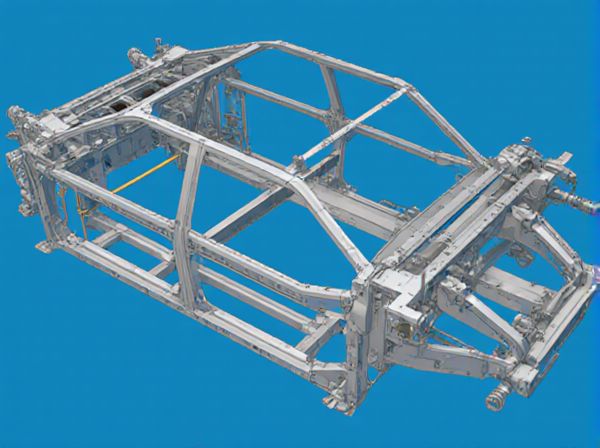
Photo illustration: Detachable Subframe vs Integral Subframe
A detachable subframe offers the advantage of easier repairs and replacements, reducing labor time and costs during collision repairs. Integral subframes, being welded directly to the vehicle body, provide increased structural rigidity and improved handling performance. You should consider the trade-off between maintenance convenience and structural strength when choosing between these two subframe types.
Table of Comparison
| Feature | Detachable Subframe | Integral Subframe |
|---|---|---|
| Structure | Separate frame bolted to chassis | Integrated into main chassis |
| Weight | Heavier due to added components | Lighter with unified structure |
| Repair & Maintenance | Easy removal for repairs | Complex and costly repair |
| Manufacturing Cost | Higher due to multiple parts | Lower with fewer components |
| Structural Rigidity | Moderate rigidity, potential flex | Higher rigidity and strength |
| Customization | Flexible for aftermarket upgrades | Limited modification options |
Introduction to Automotive Subframes
Automotive subframes serve as crucial structural components designed to support the engine, suspension, and drivetrain while isolating vibrations from the vehicle body. Detachable subframes allow for easier repair and replacement, improving maintenance efficiency, whereas integral subframes are welded directly to the chassis, enhancing vehicle rigidity and reducing overall weight. Selecting between detachable and integral subframes impacts manufacturing processes, vehicle dynamics, and repair costs significantly.
What is a Detachable Subframe?
A detachable subframe is a structural component in vehicles designed to be easily removed from the main chassis or body, allowing for straightforward access to the engine, suspension, or other mechanical systems. It enhances repair efficiency and customization by isolating key assemblies from the main frame, reducing labor time and costs during maintenance or modification. Unlike integral subframes, which are permanently welded or bolted to the chassis, detachable subframes optimize flexibility and ease of assembly in automotive manufacturing.
What is an Integral Subframe?
An integral subframe is a structural component of a vehicle where the subframe and chassis are designed as a single, unified unit, enhancing rigidity and reducing weight. This construction improves handling precision and crash safety by providing a more solid mounting point for suspension and drivetrain components. Vehicles with integral subframes often benefit from better noise, vibration, and harshness (NVH) control compared to those with detachable subframes.
Key Structural Differences
Detachable subframes are separate components bolted onto the vehicle chassis, allowing easier repairs and replacement, whereas integral subframes are welded directly to the body, providing enhanced rigidity and reduced weight. Detachable subframes facilitate modular assembly and maintenance but may introduce slight flex due to bolted connections; integral subframes, meanwhile, contribute to a stiffer overall structure that improves handling and crash performance. The choice between detachable and integral subframes impacts manufacturing complexity, vehicle repairability, and structural dynamics.
Installation and Maintenance Considerations
Detachable subframes offer simplified installation and easier access for maintenance and repairs, allowing mechanics to remove and replace the subframe without disassembling the entire chassis. Integral subframes, while providing enhanced structural rigidity, complicate installation and maintenance due to their fixed integration with the vehicle body, often requiring more labor-intensive procedures. Choosing between detachable and integral subframes depends on maintenance frequency and ease of component replacement desired.
Impact on Vehicle Performance
Detachable subframes enhance vehicle performance by allowing easier repairs and upgrades, which leads to improved handling and suspension tuning flexibility. Integral subframes offer greater structural rigidity, resulting in better chassis stiffness and improved crash safety, positively affecting vehicle stability. The choice between detachable and integral subframes influences overall vehicle dynamics, weight distribution, and maintenance efficiency, impacting acceleration, cornering, and ride comfort.
Weight and Cost Comparison
Detachable subframes typically weigh more due to added bolts and reinforcements, increasing overall vehicle weight compared to integral subframes, which are lighter as they form part of the chassis structure. In terms of cost, detachable subframes incur higher manufacturing and assembly expenses from complex joining processes, while integral subframes offer cost efficiency through simpler manufacturing and fewer components. Weight savings in integral subframes contribute to improved fuel efficiency, whereas detachable subframes allow easier repairs but at the expense of higher production and maintenance costs.
Repair and Replacement Scenarios
Detachable subframes enable easier and cost-effective repair or replacement by allowing removal of damaged sections without affecting the main chassis, ideal for collision repair or component upgrades. Integral subframes, being welded directly to the chassis, require complex cutting or full replacement of the entire frame section, resulting in higher labor costs and longer downtime. Repair shops often prefer detachable subframes for their modularity, which minimizes structural impact and maintains vehicle alignment post-repair.
Common Applications and Use Cases
Detachable subframes are commonly used in performance and race cars due to their ease of replacement and repair, enhancing maintenance efficiency and vehicle customization. Integral subframes are typical in mass-produced passenger vehicles, providing structural rigidity and improved crash safety by being permanently welded to the chassis. Both subframe types influence vehicle handling characteristics, with detachable subframes offering modularity benefits and integral subframes delivering enhanced structural integration.
Choosing the Right Subframe for Your Vehicle
Choosing the right subframe for your vehicle depends on factors such as repair costs, structural integrity, and ease of replacement. Detachable subframes offer simplified repairs and reduced labor time by allowing the subframe to be removed separately from the chassis, ideal for vehicles requiring frequent maintenance. Integral subframes provide enhanced rigidity and weight savings by being welded directly to the vehicle body, making them suitable for high-performance or lightweight applications where structural stiffness is critical.
 caratoz.com
caratoz.com